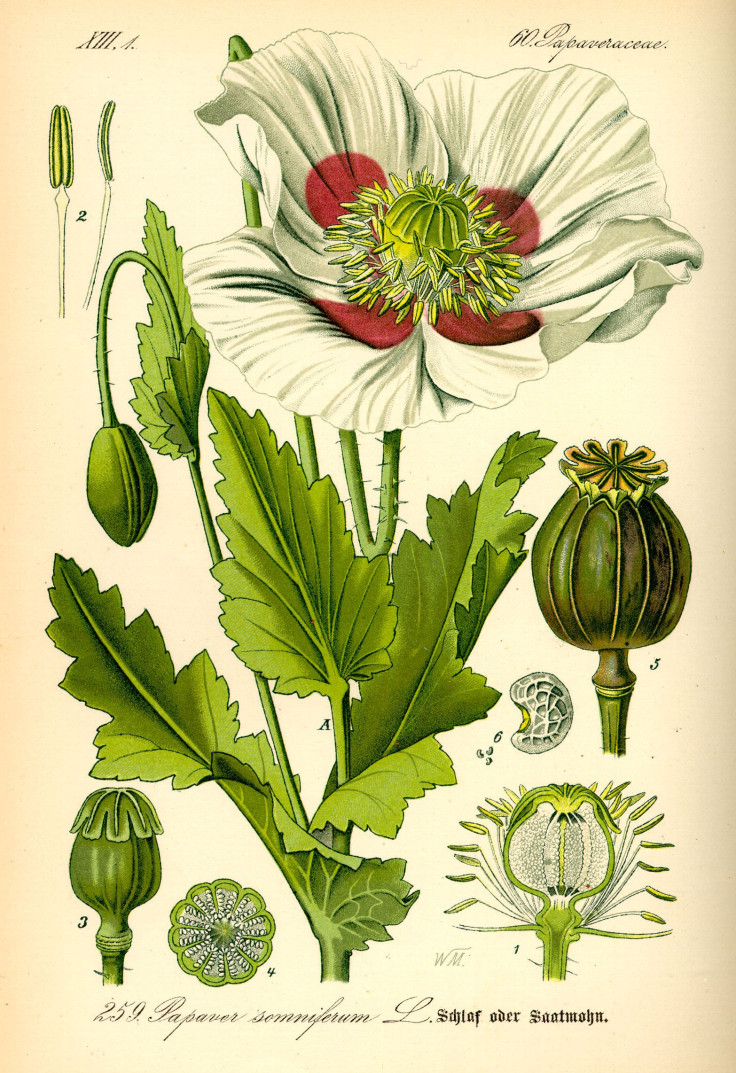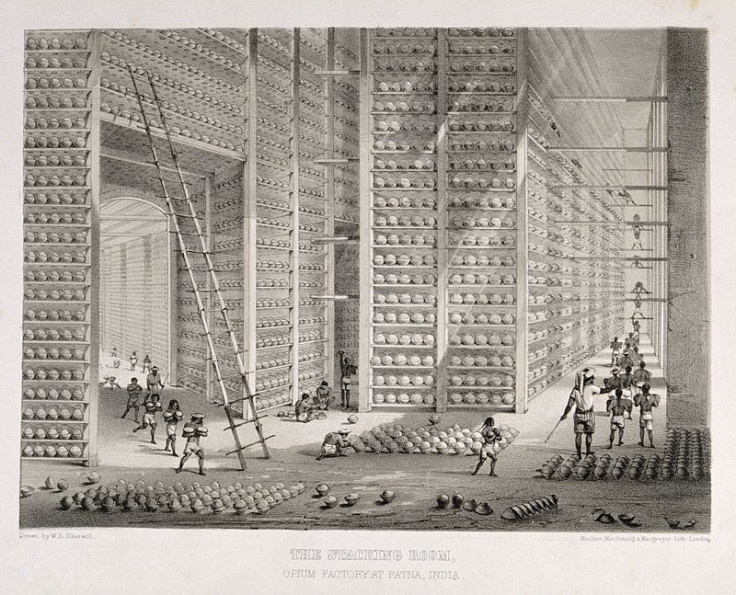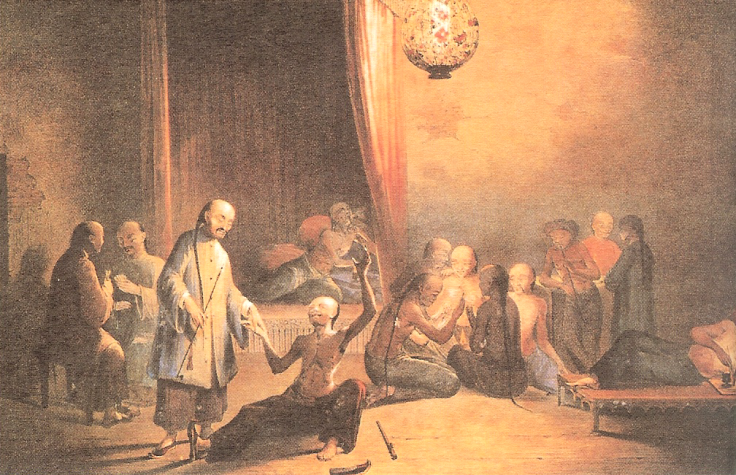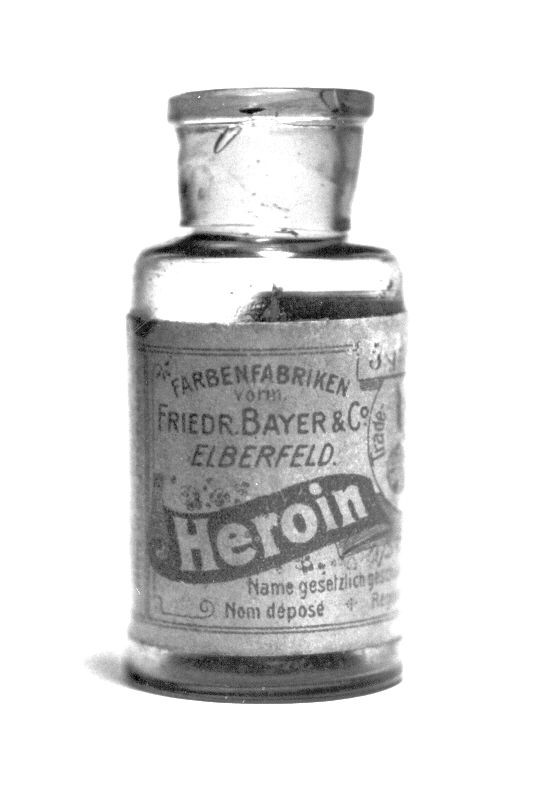How Did Opioid Drugs Get To Be So Deadly? A Brief History Of Its Transition From Trusted Painkiller To Epidemic

The term opioid today holds a wide array of connotations, many of them negative. We’ve heard about the opioid epidemic, which has risen significantly in recent years. The over-prescription of drugs like oxycodone, plus people’s subsequent addictions and overdoses. Opioid abuse has become rampant in the U.S., whether the drugs are natural opiates like morphine and codeine (made directly from poppy plants); semi-synthetic opioids like oxycodone and heroin, developed in labs from natural opiates; or fully synthetic/manmade opioids, like fentanyl, methadone, and dextropropoxyphrene.
All opioids, however, originated thousands of years ago in the form of a simple flower known as the Papaver somniferum, or the poppy plant. Here’s how this little flower went from treating pain in ancient times to fueling a current epidemic of addiction.

ANCIENT
“Presently she cast a drug into the wine of which they drank to lull all pain and anger and bring forgetfulness of every sorrow.” Homer, The Odyssey.
3400 B.C. The opium poppy is first cultivated in lower Mesopotamia. Named Hul Gil or the “Joy Plant” by the Sumerians, the plant was known to produce euphoric effects through the collection of poppy juice (opium latex, the "white milk" from the plant, which contains the naturally-occurring analgesic alkaloid morphine) in making opium.
1300 B.C. The Sumerians pass the cultivation of the opium poppy to ancient Egypt, where the capital city of Thebes develops poppy fields known as opium thebaicum. During this time, ancient Assyrians, Babylonians, and Egyptians used opium in both medicine and executions. The Ebers Papyrus, an ancient Egyptian medical document, describes using poppy grains to stop a crying child; it was also administered to patients via sponge during long surgeries.
During the next several hundred years, various civilizations gave opium religious and spiritual significance, often delegating its use only to priests, physicians, and magicians. Opium was widely cultivated, traded, smoked, and used medically.
460 B.C. Hippocrates, an ancient Greek physician known as the father of medicine, notes that opium is an incredibly useful drug in treating pain, internal diseases, and epidemics. Specifically, he mentions drinking white poppy juice mixed with the seed of nettle, noting its features as a narcotic, hypnotic, and cathartic drug, according to a report by the United Nations Office on Drugs and Crime (UNODC) website. Some one hundred years later, Alexander the Great of Greece introduced opium to Persia and India.

MEDIEVAL
"Take of Thebaic opium one ounce, of orange and lemon juice six ounces, of cinnamon and cariophilli each half an ounce. Pound those ingredients together, mix them well, and place them in a glass vessel with its covering." - Paraclesus
400 A.D. Opium is introduced to China by Arab traders.
1300. Not much is documented about opium during the Middle Ages in Europe, likely due to the fact that the Holy Inquisition had branded the Eastern drug as evil.
1483. In China, one of the first clearest depictions of opium use is written by Xu Boling, who notes that it is "mainly used to aid masculinity, strengthen sperm and regain vigor," and also that "its price equals that of gold."
1500. Portuguese traders come across opium again when trading along the East China Sea. They begin smoking the drug, noting it could affect a person instantly.
1527. It isn’t until several decades later, however, that opium is reintroduced to European medical texts and common usage. In the mid 16th century, a Swiss German philosopher and physician named Paracelsus returns to Europe after traveling throughout the Middle East, bringing back “Stones of Immortality” that contain opium thebacium and citrus juice, and are used as painkillers. Paracelsus is credited with developing laudanum, the medieval European term for opium as medicine.

MODERN
“Opium teaches only one thing, which is that aside from physical suffering, there is nothing real.” - André Malraux
1600s. Shortly after opium is reintroduced into Europe towards the end of the Middle Ages, Portuguese trade routes begin directing opium into China.
1700s. Dutch and British shipments of opium to China spark an opium epidemic, with addiction levels continuously rising. The Dutch introduce the notion of smoking opium in a tobacco pipe to the Chinese, and opium dens — shops where opium is sold and smoked — become more common in European and Chinese cities.
1729. In an attempt to quell opium epidemic in China, Emperor Yung Cheng prohibits opium smoking and selling it domestically, unless it was to be used as medicine. Despite these laws, the British East India Company was growing stronger and continued to import opium to China. In 1750, the company took control of Bengal and Bihar, huge opium markets that led to the British dominating the opium trade’s entire route from India to China.
1799. Chinese Emperor Kia King bans opium entirely.
1800. In 1729, some 200 chests of opium per year arrived from Europe to China; by 1800, that number rises to 4,500 chests, according to the Cambridge Illustrated History of China. By now, the British East India Company had established a monopoly on the opium trade, with Indian poppy growers prohibited from selling opium to other companies. Despite the Chinese ban the year before, Western traders attempt to smuggle opium into the country.

1803. In Germany, a certain Friedrich Sertürner studies opium by dissolving it in acid and neutralizing it with ammonia, discovering its active ingredient. This experiment results in alkaloids, known as Principium somniferum, or morphine. For the first time in history, the poppy plant and opium has been “tamed” into what’s considered “God’s own medicine,” a safe and effective way to treat pain. This is the beginning of the end of opium’s reign, an era that ushered in new synthetic opioids.
1839. During this time, the smuggling of opium continues into China. In 1839, Lin Tse-Hsu, imperial Chinese commissioner heading the opium suppression campaign, orders foreign traders to give up their opium. This sparks the First Opium War, as British warships are sent to the Chinese coast to protect Western mercenaries. The British ultimately defeat the Chinese in 1841, with one of the resulting concessions being that Hong Kong is given to the British.
1843. Dr. Alexander Wood, a Scottish physician, discovers that injecting morphine into patients is far more effective and three times as potent.
1874. Heroin — known originally as diacetylmorphine — is first synthesized by C.R. Wright, an English researcher working at St. Mary’s Hospital Medical School in London. By boiling morphine and acetic anhydride over a stove for several hours, he was able to produce a more potent form of morphine. The new drug is described as inducing “great prostration, fear, and sleepiness” after being injected into dogs and rabbits. It caused “the eyes being sensitive, and pupils constrict… Respiration was at first quickened, but subsequently reduced, and the heart’s action was diminished, and rendered irregular. Marked want of coordinating power over the muscular movements, and loss of power in the pelvis and hard limbs.” Despite being heroin’s predecessor, diacetylmorphine is not used widely in medicine until decades later.
1898. Chemist Felix Hoffman, working at Bayer pharmaceutical company in Germany, develops an acetylated form of morphine that is more potent. It’s dubbed “heroin,” after the German word heroisch, which means “heroic” or “strong.” For the next decade or so, heroin is produced commercially by Bayer, sold as a cough suppressant.

1910. After nearly two centuries, the British dismantle the opium trade from India to China, with physicians and experts encouraging them to do so based on the knowledge that opium is addictive.
1914. With the Harrison Narcotics Tax Act, non-clinical use of opioids, as well as cocaine, is criminalized in the U.S.
1924. The U.S. bans heroin entirely. However, in light of diacetylmorphine leaving a need for painkillers, scientists begin developing designer drugs similar to hydromorphone and dihydromorphone.
1930s-50s. More synthetic opioids are developed, including methadone, pethidine, and fentanyl. In 1950, Oxycodone is available in the U.S. in the form of Percodan tablets.
1960s-70s. The Vietnam War triggers increases in heroin smuggling into the U.S., and the number of heroin addicts in the U.S. continues to rise up to 750,000 people.
1980s. Interestingly, this decade is defined by “opiophobia,” in which most doctors were afraid of prescribing opioids to patients because of their addictive features.
1990s. Pain management changes in the 1990s, when physicians begin prescribing more opioids after noticing that pain is generally undertreated. To make up for opiophobia before, however, doctors begin prescribing a little too much morphine, fentanyl, oxycodone, and hydromorphone well into the 2000s, triggering the new opioid and heroin epidemic.
2011. The Obama administration announces it must deal with what it calls an “epidemic of prescription drug abuse.”
2016. The U.S. Centers for Disease Control and Prevention (CDC) releases its Guideline for Prescribing Opioids for Chronic Pain, hoping to curb the over-prescription of painkillers by doctors across the country. Today, over 165,000 Americans have died from prescription painkiller-related overdoses since 1999, and new research shows that the majority of patients given opioids end up with leftovers after their treatment plans.
While heroin and drug abuse in general has decreased in many European countries, in the U.S., the opioid epidemic has reached an all-time high. Since 1999, prescription opioid deaths have quadrupled, and the number of prescriptions given out has also quadrupled, according to the CDC. While there is yet no solution to the growing problem, the CDC guidelines aim to curb overprescriptions and encourage physicians to be more discerning when treating chronic pain.
Published by Medicaldaily.com



























